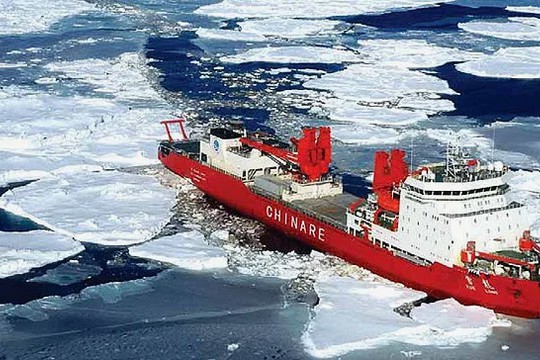Chinese icebreaker already in the Arctic.
Photo: Xinhua
The U.S. Naval Institute reported that China has successfully used the Northern Sea Route (NSR), an Arctic passage controlled primarily by Russia and long-anticipated as an alternative to the Suez, to carry Russian goods bound for Europe and Asia. The opening of the NSR presents an economic opportunity as a safer maritime trade route – and a dangerous opportunity for Russia to exert strategic control over a critical maritime chokepoint, ‘Forbs’ writes.
The NSR runs through the Arctic Sea from the Barents Sea in the West to the Bering Strait in the East. The NSR connects East Asian manufacturing centers with European consumer markets. Merchants have long eyed the NSR as an alternative shipping route to avoid congestion in the Strait of Malacca, piracy in the Horn of Africa, and instability in the Suez Canal and Middle East. They had long hoped it could cut transit times by weeks, despite shallow, icy, foggy waters that are impassible for much of the year.
Russia has long viewed the NSR’s potential to move Arctic oil and gas to Western and Eastern markets. Russia is also the only one of the eight Arctic nations that is not a member of NATO, and Russia has used lawfare, the use of law to achieve a strategic objective, to safeguard its strategic interests accordingly.
Russia has also attempted to exercise control over the NSR by instituting strict regulations on pollution and shipping safety. UNCLOS grants states the ability to regulate pollution, including indirect pollution prevention by way of safety and navigation rules to lower the risk of accidents and oil spills, in ice-covered parts of their exclusive economic zone (EEZ) where severe climate conditions create navigational hazards or could cause major environmental harm.
Russia applies regulations that are significantly stronger than generally accepted international standards. These include mandatory insurance and icebreaker escorts, both of which are expensive and exclusively controlled by Russia. These and other regulations allow Russia to assert stringent control over its illegal maritime claims — and to threaten force against vessels it deems to be out of compliance.
The U.S. and EU have argued that Russia’s interpretation of UNCLOS is contrary to international law, and that shipping and transit passage in the NSR must be governed by UNCLOS.
China has now sailed into this years-long dispute. China has declared itself a “near-Arctic nation” and stepped up icebreaker production in recent years. China has churned out new ships in just two years and is now working on a fourth icebreaker. Meanwhile, the U.S. Coast Guard’s aging fleet consists of just one heavy and one medium icebreaker. Russia has scores of icebreakers, many of which are armed, to defend its claim to the NSR.
Russia and China have announced plans to coordinate more closely on Arctic issues, including shipping and polar ship technology. China has reportedly cut transit times for China’s Russian imports to 33 or 35 days using the NSR versus 45 via the Suez Canal and 55 by going around Africa. China is known to be prioritizing dual-use technologies in its polar research that could also be used to advance its military efforts.
Despite a new ICE pact to build icebreakers with Canada and Finland announced this summer, the U.S. and its allies cannot outpace Russia and China’s icebreaker efforts in the near term.
read more in our Telegram-channel https://t.me/The_International_Affairs

 10:34 23.09.2024 •
10:34 23.09.2024 •























